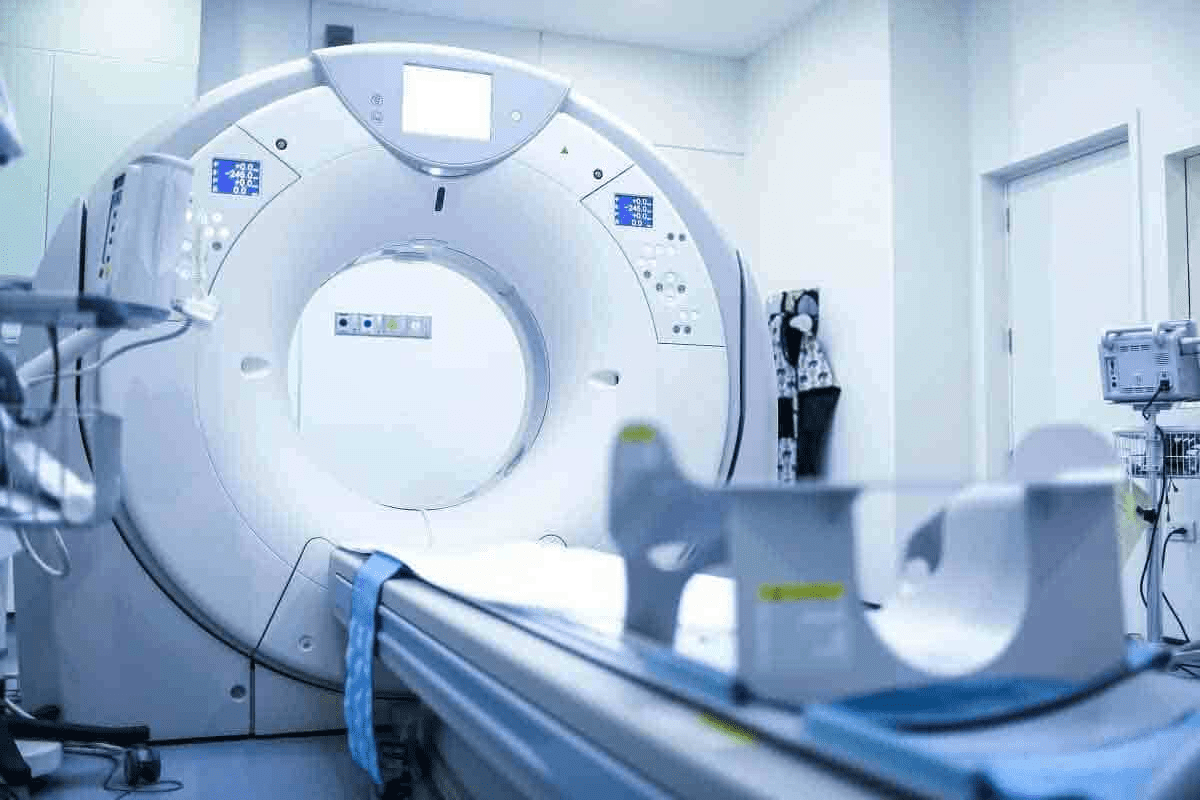Last Updated on November 26, 2025 by Bilal Hasdemir

At Liv Hospital, we use interventional radiology (IR) for new, less invasive treatments. IR is a special field that uses advanced imaging to treat without surgery.
Our interventional radiologists are key in diagnosing and treating many health issues. They use imaging to find and fix problems safely and effectively. This approach helps patients heal faster and better.
Let’s look at the common IR procedures that are making healthcare better.
Key Takeaways
- Interventional radiology offers minimally invasive alternatives to traditional surgery.
- IR procedures are performed using advanced imaging guidance for precision and safety.
- Interventional radiologists play a vital role in diagnosing and treating various medical conditions.
- Liv Hospital’s interventional radiologists deliver international standards of care.
- IR treatments can reduce recovery time and improve patient outcomes.
The Field of Interventional Radiology Explained

Interventional radiology is a medical field that uses advanced technology and precise methods to diagnose and treat diseases. It has changed patient care by providing less invasive options instead of traditional surgery.
Definition and Scope of Practice
Interventional radiology uses imaging like X-ray, ultrasound, and MRI to guide procedures. IR doctors use these tools to see inside the body in real-time. This helps them make accurate diagnoses and treatments. IR covers many areas, from vascular and non-vascular interventions to biopsies and tumor ablations.
The field of interventional radiology keeps growing, with new methods and technologies emerging. IR specialists must keep up with these advancements to provide the best care.
Historical Development of Minimally Invasive Techniques
The history of interventional radiology started in the 1960s with the first angiographic procedures. Over time, IR has made big strides thanks to better imaging and new devices. Key milestones include the introduction of angioplasty in the 1970s and the development of embolization and ablation therapies.
These advancements have made IR a unique medical field. It offers safer and more effective treatments for many conditions.
Key Differences from Diagnostic Radiology
Interventional and diagnostic radiology both use imaging, but they differ greatly. Diagnostic radiology focuses on interpreting images to find diseases. In contrast, interventional radiology uses images to guide treatments. IR requires both imaging skills and the ability to perform complex procedures.
IR also involves direct patient care. IR specialists manage patient comfort and safety during procedures. This mix of technical skill and patient care sets IR apart from diagnostic radiology.
Who Is an Interventional Radiologist?

Interventional radiologists are skilled doctors who focus on minimally invasive procedures. They use imaging technologies to diagnose and treat many medical conditions. Their training is extensive.
Specialized Training and Certification
To become an interventional radiologist, one must go through a lot of education and training. This includes:
- Completing medical school to earn an MD or DO degree
- Completing a residency program in radiology
- Obtaining fellowship training in interventional radiology
- Becoming certified by the American Board of Radiology
This training prepares them to handle complex procedures.
Daily Responsibilities and Clinical Roles
Interventional radiologists have varied daily tasks. These depend on their work setting and patient needs. Their main roles are:
- Performing image-guided procedures to diagnose and treat various medical conditions
- Collaborating with other healthcare professionals to develop treatment plans
- Evaluating patient images to determine the best course of treatment
- Providing patient care before, during, and after procedures
They are key in patient care, providing effective, minimally invasive treatments.
Collaboration with Other Medical Specialists
Interventional radiologists work with other specialists to care for patients. This teamwork is vital for:
- Developing effective treatment plans that combine the expertise of multiple specialties
- Ensuring that patients receive the most appropriate care for their condition
- Coordinating care to minimize risks and optimize outcomes
Together, they offer high-quality, patient-centered care.
Advanced Imaging Technologies in IR Procedures
Interventional radiology uses the latest imaging tech for real-time guidance. These tools are key for precise and safe IR treatments.
X-ray and Fluoroscopy Guidance Systems
X-ray and fluoroscopy are basic but vital in IR. Fluoroscopy shows X-ray images in real-time. It helps guide tools through the body for angiography and vascular work.
CT, Ultrasound, and MRI Applications
Other imaging techs also play big roles in IR:
- CT (Computed Tomography): Gives detailed images for planning and guiding.
- Ultrasound: Offers live images without radiation, great for shallow structures or when avoiding radiation is key.
- MRI (Magnetic Resonance Imaging): Shows soft tissues clearly, helping with detailed interventions.
These tools are used alone or together, depending on the IR procedure’s needs.
Real-time Imaging for Precision Treatment
Real-time imaging is key in IR, making precise navigation and treatment possible. It lets radiologists:
- Accurately target the treatment area, lowering the risk of harm to nearby tissues.
- Monitor the procedure in real-time, making changes as needed.
- Verify the immediate success of the intervention, ensuring the treatment works.
Advanced imaging in IR has greatly improved patient results by making procedures more precise and safe.
What Procedures Are Done in Interventional Radiology: An Overview
Interventional radiology is all about different procedures to diagnose and treat many conditions. These procedures are split into vascular and non-vascular interventions. Each type has its own purpose in diagnosis and treatment.
Vascular vs. Non-vascular Interventions
Vascular interventions deal with blood vessels. They treat blockages, aneurysms, and malformations. Non-vascular interventions target organs and tissues outside the blood vessels. This includes biopsies and treatments for tumors.
Examples of vascular interventions are:
- Angioplasty and stenting to improve blood flow
- Embolization to stop bleeding or cut off tumor blood supply
- Creating vascular access for dialysis
Non-vascular interventions include:
- Image-guided biopsies to take tissue samples
- Tumor ablation therapies to treat cancer
- Vertebroplasty and kyphoplasty to fix spinal fractures
Diagnostic vs. Therapeutic Applications
IR procedures serve both diagnostic and therapeutic needs. Diagnostic uses include biopsies and angiography to see blood vessels. Therapeutic uses treat conditions through minimally invasive methods.
Diagnostic IR procedures are:
- Angiography to map blood vessels
- Image-guided biopsies to diagnose conditions
Therapeutic IR procedures are:
- Angioplasty and stenting to improve blood flow
- Tumor ablation to treat cancer
- Embolization to control bleeding
Common Clinical Scenarios for IR Referrals
IR referrals are common in trauma, cancer, and vascular diseases. For example, trauma patients might need embolization to stop bleeding. Cancer patients might get tumor ablation or embolization to shrink tumors.
Other common scenarios include:
- Vascular diseases like peripheral artery disease, which may need angioplasty and stenting
- Cancer treatment, where IR procedures like tumor ablation and embolization are used
- Trauma cases, where IR procedures help control bleeding and stabilize patients
Understanding IR procedures and their uses helps healthcare providers make better decisions. This way, they can fully use interventional radiology for patient care.
Angiography: Mapping the Vascular System
In interventional radiology, angiography is a key procedure for diagnosing vascular conditions. It’s an imaging technique that lets us see the vascular system in detail. This helps us diagnose a range of vascular diseases.
Procedure Technique and Catheter Navigation
The angiography procedure involves guiding a catheter through blood vessels to the area of interest. We use X-ray or fluoroscopy for imaging guidance. This ensures the catheter is placed precisely.
Catheter navigation is a critical skill. It requires a deep understanding of vascular anatomy. We must be able to navigate the catheter through complex vascular pathways.
After the catheter is in place, we inject a contrast agent. This makes the blood vessels visible. We can then see any abnormalities, like blockages or malformations.
Diagnostic Applications in Various Body Systems
Angiography is versatile and can be applied to various body systems. It’s commonly used to diagnose and plan treatment for conditions in the coronary arteries, peripheral arteries, and cerebral vessels. Diagnostic angiography provides vital information for further procedures, like angioplasty or embolization.
In the coronary arteries, angiography helps find blockages that may cause heart attacks. In peripheral arteries, it diagnoses conditions like peripheral artery disease. In cerebral vessels, it helps diagnose aneurysms or arteriovenous malformations.
Patient Preparation and Recovery Experience
Preparing for an angiography procedure involves several steps. Patients are advised on fasting requirements and medication management before the procedure. Patient preparation is key for the procedure’s success and the patient’s safety.
After the procedure, patients are monitored for complications. The recovery time varies, but most can return to normal activities in a few days. We give detailed instructions for a smooth recovery.
Angioplasty and Stenting: Restoring Blood Flow
Angioplasty and stenting are big steps forward in treating blocked arteries. They offer hope to those with vascular diseases. These methods are less invasive and improve blood flow, leading to better health outcomes.
Balloon Angioplasty Process and Equipment
Balloon angioplasty uses a small balloon to widen narrowed arteries. It starts with a catheter inserted into the artery, guided by imaging. The balloon is then inflated to push plaque against the artery walls, improving blood flow.
The tools used include:
- Guidewires to navigate the catheter
- Balloon catheters in various sizes
- Contrast agents for clear imaging
After the balloon is deflated and removed, the artery might narrow again. To prevent this, stenting is often done alongside angioplasty.
Types of Stents and Their Applications
Stents are small, mesh-like tubes that keep arteries open after angioplasty. There are different types of stents for various needs:
- Bare-metal stents: Simple support
- Drug-eluting stents: Prevent re-narrowing with medication
- Bioresorbable stents: Dissolve over time, reducing long-term risks
The right stent depends on the patient’s condition and the blockage’s location. Drug-eluting stents are often chosen for high-risk patients.
Treatment of Peripheral Artery Disease and Other Conditions
Angioplasty and stenting treat peripheral artery disease (PAD) well. PAD narrows peripheral arteries, often in the legs. Symptoms include pain when walking and, in severe cases, gangrene. These procedures can greatly improve life quality for PAD patients.
They also help with coronary artery disease and renal artery stenosis. Angioplasty and stenting are key in managing many vascular diseases.
In summary, angioplasty and stenting are vital in modern interventional radiology. They provide effective, minimally invasive treatments for vascular diseases. Understanding these procedures helps patients and healthcare providers make better decisions.
Embolization Procedures: Controlling Abnormal Bleeding
Embolization procedures are key in interventional radiology for managing hemorrhage. They are a minimally invasive way to stop bleeding or reduce blood flow to tumors or abnormal growths. This method is vital in many medical situations, providing a less invasive option compared to surgery.
Embolic Agents and Delivery Methods
Embolization uses embolic agents to block blood vessels. These agents include particles, coils, and liquids. The right agent depends on the situation and the goal. For example, microspheres are used for tumors because they can reach deep into the tumor’s blood vessels.
Advanced catheters and imaging help deliver these agents. Microcatheters guide through blood vessels to the target. This precision helps avoid unwanted blockages and ensures the procedure works well.
Applications in Trauma, Hemorrhage, and Tumor Treatment
Embolization is used to manage trauma-related bleeding. It’s quick and effective for stopping bleeding in critical areas like the pelvis or spleen. In severe cases, it can save lives.
It’s also used for tumors. By cutting off the tumor’s blood supply, it can slow growth and ease symptoms. This is very helpful for hepatic tumors, where it can be used alone or with chemotherapy.
Uterine Fibroid Embolization and Other Specialized Procedures
Uterine Fibroid Embolization (UFE) is a specialized use of embolization. It blocks the uterine arteries to treat fibroids. UFE is a good option for women with heavy bleeding and pelvic pain from fibroids.
Other special uses include prostate artery embolization for enlarged prostate and bronchial artery embolization for bleeding in the lungs. These show how versatile embolization can be in treating different conditions.
As we improve in interventional radiology, embolization stays a key part in treating abnormal bleeding and other issues. Its non-invasive nature and effectiveness make it a valuable tool in healthcare.
Image-Guided Biopsies: Precise Tissue Sampling
Image-guided biopsies have changed how we diagnose diseases. They are a precise and gentle way to take tissue samples. This method is key in modern medicine, helping doctors diagnose with more accuracy and less risk to patients.
Core Needle vs. Fine Needle Aspiration Techniques
There are two main methods in image-guided biopsies: core needle biopsy and fine needle aspiration. Core needle biopsy uses a bigger needle to get a bigger tissue sample. This is important for diagnosing some conditions.
Fine needle aspiration uses a smaller needle to get cells from the area. It’s less invasive and quick, often without anesthesia. But, it might not always give enough information for a clear diagnosis.
“The choice between core needle biopsy and fine needle aspiration depends on various factors, including the nature of the lesion, its location, and the patient’s overall condition.”
Targeting Difficult-to-Reach Organs and Lesions
Image-guided biopsies are great for reaching hard-to-get areas. They use ultrasound, CT, and MRI to guide the needle. This makes sure the sample is from the right spot, improving accuracy and safety.
- Ultrasound-guided biopsies are common for easy-to-reach lesions.
- CT-guided biopsies are best for deeper or complex lesions.
- MRI-guided biopsies are great for soft tissue, ideal for some lesions.
Safety Profile Compared to Surgical Biopsies
Image-guided biopsies are safer than surgical biopsies. They are less invasive, causing less damage and risk of infection. Patients usually feel less pain and can get back to normal faster.
A study found that image-guided biopsies have fewer complications than surgical biopsies. This makes them a safer choice for patients.
In conclusion, image-guided biopsies are a big step forward in medicine. They offer precision, safety, and are less invasive. As technology gets better, these methods will help care for patients even more.
Tumor Ablation Therapies: Targeted Cancer Treatment
Tumor ablation is a new way to treat cancer. It uses heat or cold to kill cancer cells while keeping healthy tissue safe. This method is getting more attention because it’s less invasive and works well for many cancers.
Ablation Methods
Tumor ablation therapies use different ways to destroy cancer cells. The main methods are:
- Radiofrequency Ablation (RFA)
- Microwave Ablation (MWA)
- Cryoablation
Each method has its own benefits. RFA uses electrical currents to heat up cancer cells. MWA uses microwave energy for the same purpose. Cryoablation freezes cancer cells to death.
| Ablation Method | Mechanism of Action | Common Applications |
| Radiofrequency Ablation (RFA) | Uses high-frequency electrical currents to generate heat | Liver, kidney, and bone tumors |
| Microwave Ablation (MWA) | Employs microwave energy to heat and destroy cancer cells | Liver, lung, and kidney tumors |
| Cryoablation | Utilizes extremely low temperatures to freeze and destroy cancer cells | Kidney, liver, and prostate tumors |
Patient Selection and Treatment Planning
Choosing the right patient for tumor ablation is key. Doctors look at tumor size, location, and the patient’s health. A team of doctors, including radiologists and oncologists, plan the treatment. They make sure the treatment fits the patient’s needs and cancer type.
Integration with Other Cancer Therapies
Tumor ablation often goes hand-in-hand with other cancer treatments. This can include chemotherapy, radiation, and surgery. Combining treatments can lead to better results for patients. For example, ablation can shrink tumors before surgery or kill leftover cancer cells after surgery.
Knowing about tumor ablation therapies helps doctors give patients the best treatment. This can improve patients’ lives and survival chances.
Vascular Access and Port Catheter Placement
For many patients, vascular access and port catheter placement are key for ongoing medical care. These steps create a pathway for medications, nutrients, or dialysis. This greatly improves patient care and comfort.
Central Venous Access Devices and Implantable Ports
Central venous access devices (CVADs) and implantable ports are vital for long-term intravenous therapy. CVADs let doctors give medications, chemotherapy, and nutrients directly into a large vein. Implantable ports are surgically placed under the skin for safe, repeated infusions.
Benefits of CVADs and Implantable Ports:
- They have a lower risk of infection than peripheral IV lines
- They allow safe administration of dangerous medications
- They make treatments more comfortable by reducing needle sticks
- They support long-term treatment plans
Dialysis Access Creation and Maintenance
For patients with end-stage renal disease, dialysis access is essential. Vascular access for dialysis can be made through arteriovenous (AV) fistulas, AV grafts, or central venous catheters. Keeping dialysis access in good condition is vital to avoid problems like thrombosis and infection.
| Type of Dialysis Access | Description | Advantages | Disadvantages |
| Arteriovenous Fistula | Surgical connection between an artery and vein | High blood flow rate, lower risk of infection and thrombosis | Requires maturation time, primary failure risk |
| Arteriovenous Graft | Synthetic tube connecting an artery and vein | Quicker to establish than AV fistula, durable | Higher risk of thrombosis and infection than AV fistula |
| Central Venous Catheter | Catheter placed in a large vein | Immediate use, less invasive | Higher risk of infection, limited durability |
Long-term Management and Possible Complications
Managing vascular access devices long-term means watching for signs of infection, thrombosis, or mechanical failure. Patients and healthcare providers must work together. This includes regular sterile dressing changes and using antimicrobial lock solutions when needed.
Potential complications include catheter-related bloodstream infections, thrombosis, and mechanical issues. Early detection and action are key to managing these problems well.
Vertebroplasty and Kyphoplasty: Spinal Fracture Treatment
Spinal fractures can be very painful and limit movement. Vertebroplasty and kyphoplasty are new ways to fix this problem. They help make the spine strong again without a big surgery.
These treatments are part of interventional radiology. They help people with spinal fractures, often caused by osteoporosis. They bring relief from pain and make the spine more stable.
Techniques and Equipment Used
Vertebroplasty fills the broken vertebra with bone cement. Kyphoplasty uses a balloon to make space before filling with cement. This helps restore the vertebra’s height.
Doctors use special tools and imaging like fluoroscopy or CT scans. This ensures the procedure is done right.
The tools needed are needles, balloons for kyphoplasty, and bone cement. The choice between the two treatments depends on the fracture’s severity and the patient’s health.
Selecting Appropriate Candidates
Finding the right patients is key for these treatments to work. The best candidates have osteoporotic compression fractures that haven’t gotten better with other treatments. But, some people might not be good candidates, like those with infections or certain symptoms.
Pain Relief and Recovery
Both treatments can greatly reduce pain for many patients. Recovery is usually quick, with most people feeling better in a few days. Some might even go home the same day.
It’s important to slowly get back to normal activities. Doctors will guide patients to avoid hurting themselves again.
| Procedure | Pain Relief | Recovery Time |
| Vertebroplasty | Significant | 1-3 days |
| Kyphoplasty | Significant | 1-3 days |
In conclusion, vertebroplasty and kyphoplasty are great for treating spinal fractures. They offer pain relief and stability through small procedures. Knowing about these treatments, who they’re for, and what to expect is important for both doctors and patients.
Conclusion: Benefits and Future of Interventional Radiology
Interventional radiology has changed medicine a lot. It offers treatments that are less invasive, which means less risk and pain for patients. Patients also get to recover faster than they would with old surgical methods.
Looking ahead, interventional radiology will keep getting better. New treatments will be available for many health issues. Thanks to better imaging tech, doctors can do more precise and effective treatments.
The future looks bright for interventional radiology. There’s a lot of research going on to make treatments even better. We’ll see more use of minimally invasive treatments, making IR a key part of healthcare.
Healthcare providers can give patients the best care by using these new advancements. This way, they can really make a difference in people’s lives with interventional radiology.
FAQ
What is interventional radiology?
Interventional radiology (IR) is a medical field that uses small, precise procedures to treat diseases. It uses advanced imaging like X-ray and MRI to guide tools to the right spot in the body.
What does an interventional radiologist do?
An interventional radiologist is a doctor who performs minimally invasive procedures. They use imaging to diagnose and treat many conditions, like vascular diseases and cancer.
What kind of training do interventional radiologists receive?
They get a lot of training, including medical school and fellowships. They also need to pass a certification exam from the American Board of Radiology.
What are some common procedures performed in interventional radiology?
IR procedures include angiography, angioplasty, and stenting. They also do embolization, biopsies, and tumor ablation. Other procedures include vascular access and vertebroplasty.
What is the difference between diagnostic and therapeutic IR procedures?
Diagnostic procedures, like angiography, help find diseases. Therapeutic procedures, like angioplasty, treat conditions.
Are IR procedures safe?
IR procedures are usually safe when done by skilled doctors. But, like any treatment, there can be risks and side effects. These will be talked about before the procedure.
How do I prepare for an IR procedure?
Preparing for an IR procedure depends on the treatment. You’ll get instructions on what to do before, like fasting or stopping certain medicines.
What is the recovery time for IR procedures?
Recovery time varies by procedure and patient. Some need just a short stay, while others may need longer recovery at home.
Can IR procedures be used in conjunction with other treatments?
Yes, IR procedures often work with other treatments like surgery or chemotherapy. This gives patients a more complete care plan.
Are there any alternatives to IR procedures?
There might be other treatments, like surgery or medicine, for some conditions. Doctors will discuss the best options with patients and their teams.
What is the role of imaging in IR procedures?
Imaging technologies like X-ray and MRI are key in IR. They help guide tools to the right place in the body.
How do interventional radiologists collaborate with other medical specialists?
IR doctors work with surgeons, oncologists, and primary care doctors. They team up to give patients the best care and treatment plans.
References
Majumdar, A., et al. (2024). Current trends in herbal medicines targeting renal cell carcinoma. Phytomedicine, 131, 152837. https://www.sciencedirect.com/science/article/abs/pii/S2950199724001174






